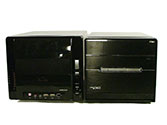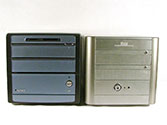Size Comparisons
One thing that isn't really clear from our pictures so far is the relative sizes of the cases. Being that this is the Small Form Factor market, a lot of people are going to be concerned with how large each unit is. To give you an idea of the sizes, we have included several comparison shots with the units. The larger units do have the advantage of additional room for hard drives, of course, so there really is no "one size fits all" choice. |
 |
| Click on images to enlarge. | |
 |
 |
| Click on images to enlarge. | |
The G5 chassis is clearly the smallest of any of the units, with both the SN95G5 and ST20G5 being identical in size. The 330P is slightly larger, with a relatively significant increase in size from the 330P to the EQ3901. Coming in as the largest of all the 939 SFFs is the SN25P. Not surprisingly, it also packs in the most features and expansion options (other than the lack of a PCI slot).
| System Dimensions in mm (Width x Height x Depth) | |
| Biostar 330P | 215 x 185 x 355 |
| Shuttle SN25P | 210 x 220 x 330 |
| Shuttle SN95G5 | 200 x 185 x 310 |
| Shuttle ST20G5 | 200 x 185 x 310 |
| Soltek 3901-300P | 215 x 200 x 340 |
You can see the dimensions of the cases all at a glance in the above table. Note that these are our own measurements, and while they agree for the most part with the manufacturers' dimensions, a few numbers were off by as much as a centimeter. We included the length of any thumbscrews or any other protrusions on the rear of the case, and we did the same for the farthest point on the front of the case as well. We've also made a chart of the volumes of the cases by multiplying length * width * height.

One last comment on the size is that it can be a bit tricky installing larger graphics cards into these small cases. The G5 chassis in particular requires a bit of finesse, and even the hinged design of the 330P doesn't make it simple to install our X800 Pro. The cards did fit in all of the units, and we're happy to report that they all ran without issue. The SN25P and the 3901-300P both have the most clearance around the GPU slot and were the easiest in which to install the graphics card. Of note is that out of these five units, only the SN25P can accommodate a dual slot GPU like the X850 XT PE or 6800 Ultra. So, if you have one of those or plan to purchase one, your SFF selection is very limited. It's a minor point, however, as the current champ of GPUs - the 7800GTX - is once again a single slot solution.










29 Comments
View All Comments
JarredWalton - Friday, August 12, 2005 - link
I'll hit the KLOSS as soon as I can. (I have it already.) So unless someone else votes, I guess I'll get the KLOSS reviewed next.Sokolum - Thursday, August 11, 2005 - link
For the last 2 months now i have a ST20G5 using as a MCE system. There are a few problems what i have encounbtered, one of them is that the system behaviour changes when i change a setting within the BIOS. Those aren't dramatic changes. But with every change, it looks like that the graphics runs muchmore slower, you can see this with dragging a windows screen over your desktop, you get trails from that window...The system only runs smooth when i *don't* touch those setting. Happily the things keep running smoothly when i enlarge the shared video memory.
For the MCE side, i failed to make the Hauppauge 500MCE run compleetly as it should, i am only able to run TV 'Tunner 1' without problems when i *disable* TV 'Tunner 2' within windows Device Manager. Shuttle or Hauppauge couldn't help me with this case.
As the review documented, this is one of the cases that RAID is causing the problem in this story. In my MCE setup, i don't use RAID (there is *no* room for a seccond drive when you installed a floppy drive). Why RAID is the problem, what i have been told is that RAID wants to use al of the PCI bandwith. It seems the nature of RAID in this kind of systems, just een told, i am not for 100% sure, but it seems plausible to mee.
, a nice looking machine. I solved the problem for the flash cards with buying a floppy disk what come with a integrated card readed, see link:
http://www.alternate.nl/html/shop/productDetails.h...">http://www.alternate.nl/html/shop/productDetails.h...
mino - Thursday, August 11, 2005 - link
Jared I must confes, this is the _first_ time i see everclocking test done as it should have been. I really appreciate the comments for newbies (it makes easier to me to explain to them if you could reference somthing :). Also finally use of correct term oo A64 base freq./FSB issue. I think this way is it should be done for _all_ A64 motherboard review.1) do a maximum base freq. check (by keeping memfreq. around DDR400 + CPU not overclocked
2) do a max memclock test at 1T (with some proven components, just to check quality of CPU to MEM routing on the MB)
3) do some max. overclock test (actually this may be optional since it depend mostly CPU chosen)
Keep at this route and many readers may finaly undestand the basics of A64's OCing.
JarredWalton - Thursday, August 11, 2005 - link
I'm working on some detailed overclocking articles right now. Glad you enjoyed the section, and I'll be going into a LOT more detail (with benchmarks) on some future OC articles.dropadrop - Thursday, August 11, 2005 - link
Thanks for the nice review,If you are considering a followup I would love to see you test usb. While the usb on my sn95g5 v2 works for casual things like a mouse, digital camera and memory card reader, it does not work for an ipod shuffle, external soundcard (hercules dj console), or external hardisk.
There have been alot of people with similar experiences. It wold be great if you could find a way to test the sff's with a few "demanding" usb devices, and even measure the voltage (and stability of it) supplied via usb.
I also second the request for you to test the sn95g5 with an X2. The new bios surely supports them, as people in north america have been getting their current rigs modded by shuttle for support. I would love to see how your's supports it (and maby even venice / san diego) without being modded. I believe you would have the chance to help alot of confused SN95G5 users by trying out a few cpu's in it.
JarredWalton - Thursday, August 11, 2005 - link
I will definitely give it a shot. At present, my intention is to purchase an external IDE HDD enclosure with USB2.0 and 1394A support and do some file transfers and such between that and the system. The problem with that approach is that the enclosures all have an external power source. Can anyone recommend an inexpensive USB/Firewire HDD enclosure that gets the power over the USB port? http://www.newegg.com/Product/Product.asp?Item=N82...">I found this one, but I'm not really keen on spending $160 for something I don't personally need.dev0lution - Wednesday, August 10, 2005 - link
How come the SN25P details don't mention the update from nforce4 standard to nForce4 Ultra? I'm thinking of getting one so I went to the previous review and it lists chipset in the specs as the nForce 4 standard, but if you go to Shuttle's current product page for the SN25P it lists the chipset as the Nforce4 Ultra. Who's correct?JarredWalton - Thursday, August 11, 2005 - link
I think I may have just been lazy or neglectful in the original SN25P article. I'm pretty sure it was always nForce4 Ultra. Then again, regular nf4 vs. nF4U only adds SATA-II support IIRC. I don't see anything about SN25P supporting SATA-II which is sort of odd.Cookie Crusher - Wednesday, August 10, 2005 - link
I know it may be a "dated" or more "Entry Oriented" socket, but I have found that the socket 754 SFF systems are great for gaming and general use. Was there ever a roundup for them? If not, I'd like to see maybe a limited look at them to remind everyone that they are viable alternatives to, and about $75-$100+ cheaper than, these socket 939 options.I think it's important to point this out because of the note in the article that a SFF option incurs a premium....maybe so, but there are still cost effective options in that market. thanks.
Cookie Crusher - Wednesday, August 10, 2005 - link
Nevermind.....i found the roundup I was hoping for.....still, would be nice to make that reference to the older socket types as legitimate choices for SFF hopefuls on a budget. :-)